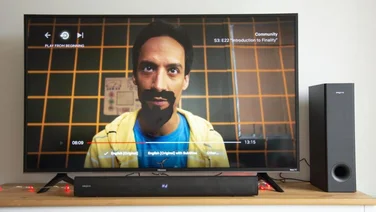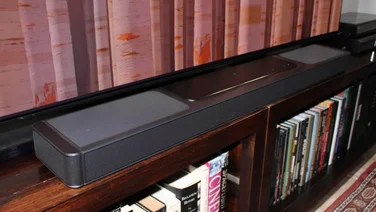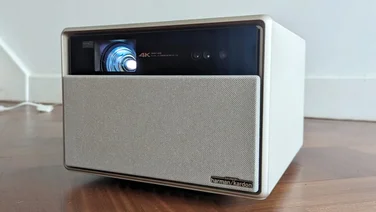To help us provide you with free impartial advice, we may earn a commission if you buy through links on our site. Learn more











- Comprehensive HDR support
- Sharp 4K pictures
- Balanced and subtle colours
- Some backlight inconsistency
- Slight greyness over dark scenes
- So-so upscaling
TCL’s TV division has had quite the year. By managing to completely revamp the hardware and software in its current range without having a noticeable impact on its aggressive pricing, the brand has delivered a procession of high-performance bargains.
The P7K, though, will be perhaps the ultimate test of TCL’s bang for your buck talents, coming it is does from the lower reaches of the manufacturer’s TV range. Can such a relatively stripped-back set still stand out from the crowd?
TCL P7K review: Key specifications
| Screen sizes available | 43in (43P7K), 50in (50P7K), 55in (55P7K), 65in (65P7K), 75in (75P7K) and 85in (85P7K) |
| Panel type | Direct-lit QLED |
| Resolution | 4K/UHD (3,840 x 2,160) |
| Refresh rates | Native 60Hz, but supports 120Hz via Game Accelerator mode |
| HDR formats | HDR10, HLG, Dolby Vision, HDR10+ |
| Audio enhancement | 2 x 10W speaker system, Dolby Atmos, DTS Premium Sound |
| HDMI inputs | 3 (one with eARC) |
| Freeview Play compatibility | No |
| Tuners | Terrestrial Freeview HD |
| Gaming features | 120Hz via Game Accelerator, ALLM, VRR, Game Bar, Dolby Vision gaming mode |
| Wireless connectivity | Bluetooth 5.2, Wi-Fi |
| Smart assistants | Google Assistant |
| Smart platform | Google TV |
What you need to know
Even by TCL’s pricing standards, the P7K is a budget TV range. Inevitably, this means it lacks some of the features that have served the higher reaches of TCL’s LCD TV range so well this year, including local dimming, mini LED lighting and a 120Hz panel.











It does, however, still use TCL’s latest generation of direct-lit HVA panel technology (albeit a rather entry-level edition), as well as retaining quantum tot colour and good high dynamic range and gaming support.
Price and competition
The smallest entry in the P7K range – the 43in model I tested – will set you back £269. That’s already a very tidy looking deal, but the value looks even stronger as you move up the P7K screen sizes, with the 50in costing £299, the 55in costing £379, the 65in costing £529, the 75in costing £599 and the 85in priced at a jaw-dropping £899.
The main competition for the P7K is actually TCL’s own step-up P8K. This adds a 120Hz panel, more powerful image processing and a more premium, Onkyo-designed sound system to the party, though the directness of the challenge posed to the P7K by the P8K varies between screen sizes; at the 65in and 75in level, there’s a healthy £70 and £200 respectively between the P7K and P8K equivalents. Unfortunately for the 85in model, the 85in P8K actually costs the same…
Hisense, not surprisingly given the intensity of its rivalry with TCL, has an E6Q range that’s priced very close to the P7K and adds support for Freely to the feature list. You can pick up the 43in model for £219, but the E6Q range doesn’t carry a quantum dot colour system, and we’re yet to test one out.
Design, connections and control
The P7K’s screen frames are narrow and dressed in a pleasing textured black finish that helpfully disguises its plasticky heart. The screen sits on a pair of fairly bog-standard shiny black plastic feet, though, and sticks out a bit more around the back than many of today’s uber-svelte TV supermodels. Overall, while the P7K might not set the Paris catwalks alight, it doesn’t look quite as cheap as it is.
Its connections are respectable for such an ultra-affordable TV range. Three HDMIs lead the way, providing support for a few HDMI v2.1 features such as 120Hz at sub-4K resolution if you activate TCL’s Game Accelerator technology, auto low latency mode (ALLM) switching, and even support for variable refresh rates (VRR) that includes the AMD Freesync format.











Elsewhere are a couple of USB ports, an optical digital audio output, terrestrial aerial and satellite inputs, and an Ethernet network port. Most users will prefer to use the TV’s built-in Wi-Fi and Bluetooth connectivity rather than physically tethering the TV to a router.
The P7K ships with a lightweight and overtly plasticky remote control that’s packed with buttons rather than being stripped back like some of today’s smart remotes are. The layout is quite helpful, though, with large, well-spaced-out buttons and a small cluster of direct video streaming app keys. You can also control the P7K just by talking to it, surprisingly for such a cheap TV, courtesy of its Google Assistant support.
Smart TV platform
The P7K uses the Google TV smart platform. This is more attractively presented and substantially less buggy than its Android TV predecessor. Still, it isn’t great at figuring out content recommendations that might interest you, and it doesn’t include the catch-up apps for all of the UK’s main terrestrial broadcasters by default.











Happily, though, TCL has managed to get those missing catch-up apps on board, presumably by working directly with the broadcasters in question. There’s no Freeview Play or Freely support, though.
Image quality
The P7K is, for the most part, a very likeable SDR performer. Not least because it manages to provide a series of cleverly designed (for this level of the market) picture presets that cater well for different room conditions and tastes.
The Standard mode’s starting point is to flood SDR images with the maximum brightness the P7K can achieve – around 330cd/m2, to be precise, according to my Portrait Displays’ Calman Ultimate software, G1 signal generator and C6 HDR5000 colorimeter. This gives SDR images a nice level of punch and intensity without the results looking either garish or washed out.











On the contrary, the P7K is remarkably good for the money at ensuring colours retain good balance and impressive shading subtleties in Standard mode, despite the light engine lacking the refinement and local controls available to TCL’s more expensive models.
There does seem to be a degree of global dimming going on in the standard mode, though, where the whole backlight is adjusted in response to changes in the image content. This helps the set deliver really quite respectable black levels by budget TV standards, while also retaining plenty of shadow detail.
The combination of good colour subtlety and shadow detail retention helps the pictures look sharp with native 4K content, and the Natural Cinema and Low motion processing setting options both do a solid job of suppressing 24p judder without generating distracting side effects.











While the P7K takes admirable care to keep its colours and lighting balanced in Standard mode, it’s predictably not very accurate to the official Rec 709 SDR standards. Calman Ultimates’ Colour Checker, Saturation Sweep and Luminance Sweep tests record Delta E 2000 average errors of 8.8, 9 and 7.8, respectively – all clearly, if not spectacularly, outside the 3 error threshold considered imperceptible to the human eye.
The screen’s lack of local light controls is apparent in 2-point and multi-point grayscale Calman tests, too, which record double-figure Delta E 2000 average errors of 12.9 and 11.3. Let’s not forget, though, that this is a budget TV that pushes for more brightness than most of its similarly priced competition. So while you can see these levels of errors appear in the greyness and occasionally slightly noisy look of Standard Mode dark areas, images are still easy to enjoy. Especially in a fairly bright room, where the dark area errors stand out less.
The more accuracy-focused Movie mode doesn’t deliver completely satisfactory results. The first thing you notice is that the 330cd/m2 in the Standard mode becomes just 114cd/m2 in Movie Mode, inevitably meaning pictures aren’t as punchy and don’t really hold up in bright rooms.











The more subdued brightness is actually appropriate to SDR standards, though, and contributes to more accurate Calman test results. There’s much less of a tracking discrepancy between the RGB colour constituents in this mode, making for a more consistent colour temperature. Also, while 2-point and multi-point grayscale measurements still reveal Delta E 2000 average errors of 7.2 and 6.3, there’s noticeably less noise and greyness in dark areas than there is in Standard mode. The P7K track the SDR EOTF almost perfectly, too, as well as covering pretty much 100% (99.4% to be precise) of the Rec.709 colour gamut.
While colour in Movie mode initially feels rather subdued after experiencing the Standard preset, once you acclimatise to it, it’s actually rather impressive. Especially in the subtleties of tones and blends they render. It’s no surprise to find Calman’s ColorChecker, Saturation Sweep and Luminance Sweep tests returning measurements of 3.9, 4 and 3.6 in Movie mode that sail very close to full accuracy to the Rec.709 norms.
My biggest gripe with the P7K’s SDR pictures is that while they hold up reasonably well with HD sources, upscaled SD pictures tend to look rather soft and noisy. Not unwatchably so, but it does take the edge off what’s generally a strong SDR picture effort.
HDR performance
While the P7Ks’ 330cd/m2 or so of peak brightness is hardly rock and roll by today’s HDR standards, it’s a decent amount of light to be getting from such an ultra-affordable TV. Yes, it’s not enough to unlock the full range and impact of most HDR source images, not by a long chalk. But it is enough to give HDR extra vibrancy and a real gleam in its eye – literally – compared with SDR.
This is even true compared with the Standard SDR preset, which essentially uses the same level of brightness. I guess the extra light just hits different when fed into the wider colour gamuts and light values that HDR natively supports.
HDR colours aren’t as vibrant or voluminous as those found on TCL’s step-up TVs, which is to be expected given how relatively lacking in both general brightness and local light control the P7K is. However, the fact that it clings to a basic quantum dot colour system means that even the brightest HDR shots don’t look desaturated. At the same time, TCL’s processing keeps HDR’s wider colour range in balance and creates a sense of depth and naturalism.











Having more native colour and brightness to work with from HDR content makes it even easier to appreciate just how sharp and detailed the P7K is with native 4K sources. It also highlights how well that sharpness holds up with 24p movie sources thanks to the ability of TCL’s AiPQ processor to suppress judder and motion blur without leaving images looking excessively processed.
There are a few HDR grumbles to report. Black levels with HDR look noticeably greyer than those of TCL’s Mini LED TVs, albeit not enough to truly spoil dark scenes, and nowhere near as much as you see with many similarly affordable budget TVs. Next, small, faint jets of light creep into the bottom corner of dark shots, and finally, the Dynamic Contrast setting can cause some flickering during dark scenes. If you turn this off, black levels, contrast and shadow detail during dark scenes all take a palpable hit, so there’s no winning here.
Turning to the objectivity of my Calman Ultimate tests, the expected pattern of the HDR Standard preset dishing up a more punchy but less accurate picture than the Movie Mode continues.
In HDR Movie Mode, which reins in brightness to around 260cd/m2 rather than the panel’s maximum, ColorChecker, BT.2020 Saturation Sweep and P3 Saturation Sweep tests record Delta E 2000 average errors of 3.6, 4.5 and 3.9 respectively – impressively close to our target error level of 3. This low level of error looks especially good in the context of a budget TV capable of covering 74.72% of the BT.2020 colour spectrum and 93.15% of the P3 spectrum.











In Standard mode, the same ColorChecker, BT.2020 Saturation sweep and P3 Saturation tests record much higher error levels of 10.61, 10.8 and 10.24. While the HDR Standard mode might not be tracking creative intent as closely as the Movie mode, it still looks convincing thanks to the way no colours or highlights look out of kilter with the rest of the image. The Standard mode’s bolder saturations only marginally reduce the amount of subtle shading the image contains, too.
Unusually there’s one outlier in the Movie Mode’s measurements, as the ColorMatch test, featuring a patch set derived from actual HDR content rather than established industry standard values, turns in a Delta E 2000 average error of 10.13 (which only drops a little to 7.87 with luminance taken out of the equation) that’s only a couple of points below the figure the P7K delivers in their Standard HDR preset. You don’t really feel this individual error with real-world viewing, though, as the Movie Mode delivers a clearly more balanced, authentic-feeling colour performance than the Standard mode.
In fact, the Movie mode is overall remarkably watchable for such an affordable TV, avoiding the general drabness and inconsistencies often seen with budget TVs’ most accurate modes.
To test the TCL P7K, I used Portrait Displays Calman colour calibration software.
Gaming
The P7K enhances its already excellent value by also being a talented gaming display. While in Game mode (which can be activated automatically when a game source is detected, thanks to the TV’s ALLM support), the screen only takes 10.8ms with 1080p/60Hz feeds to render incoming game graphics. That’s faster than many flagship TVs out there.
The resulting responsive feel to gaming on TCL’s budget screen is enhanced by its clean, crisp playback of 60Hz 4K sources, which emerges free of softness or judder, while effective support for VRR means there’s no trouble with screen tearing.











The Game Accelerator system delivers 120Hz support as promised, though personally, I felt other aspects of the image, especially sharpness and edge definition, felt a bit too compromised in this mode for comfort, leaving me sticking with the 4K/60Hz option.
The P7K’s generally strong colour and contrast for such an affordable screen seal the deal on a consistently fun and rewarding gaming experience.
Sound quality
The P7K’s sound system inevitably doesn’t hit the heights that most mid-range and high-end TVs do. There’s a rather thin quality to dense action or horror scenes, and dialogue can start to become overwhelmed when the going gets tough.
The speakers do manage to create a decent soundstage size by budget TV standards, though. The sound extends beyond the left and right sides of the screen, especially when it comes to placing score work slightly outside the rest of a mix. And, even though the two included speakers only fire down from the screen, they create a mild sense of sound pushing forward rather than everything sounding like it’s happening behind the panel.











While it can’t hit particularly low frequencies, the P7K does deliver just enough bass to underpin its sound. This can break down into some quite alarming crackling with the movie world’s heaviest bass moments, but sound is enjoyably free of distortions for the most part. There’s just enough bass, too, to stop high-pitched ambient effects from sounding hissy or too bright.
In the end, the P7K is perfectly comfortable to listen to most of the time, which is more than can be said for many other TVs at the same price level.
Verdict
While some P7K screen sizes suffer from not achieving enough of a price saving over TCL’s step-up P8K models, the P7K range combines a very respectable set of gaming and smart features with levels of performance superior to those that most of the rest of the budget TV world can muster.






